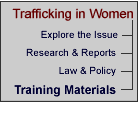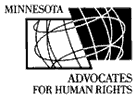|
|
|
TRAINING MATERIALS The United Nations, Council of Europe, European Union and the Organization for Security and Cooperation in Europe (OSCE) have all recommended training programs as an integral aspect of anti-trafficking initiatives. A comprehensive training program should focus on a variety of professionals whose work is connected with trafficking in women and include training initiatives that range from general awareness-raising to specific policy development and implementation. A 1996 European Union Joint action establishing an incentive and exchange program for persons responsible for combating trade in human beings (known as the STOP program), identifies key actors as beneficiaries of training courses, exchange programs and seminars. These key actors include judges, prosecutors, police departments, civil servants, immigration officials, border agents and social service providers who assist victims of trafficking. Other participant groups include politicians, the media, healthcare professionals, students, groups at risk for trafficking and the general public. A 2002 report by Barbara Limanowska for UNICEF/ UNHCR/ OSCE, Trafficking in Human Beings in Southeastern Europe, summarizes the many training initiatives that non-governmental organizations (NGOs), international institutions and law enforcement structures have undertaken in the region. Such training initiatives include: general-awareness raising, training on trafficking as a legal and human rights issue, training on working with trafficked persons, training for law enforcement officers and training of trainers. The joint report specifically finds that in Southeastern Europe there is a need for more targeted trainings that are based on the current legal and institutional framework in each country. In other regions and countries, however, there is still a need for more general training sessions that raise awareness about trafficking in women as a human rights abuse. This site offers sample introductory-level training sessions on trafficking in women as a violation of human rights and the dimensions of the problem. These sessions can be used for general awareness-raising and as introductions to later training sessions that reflect country conditions. These sample sessions are found in the Identifying the Problem and Researching the Problem blocks, below. The creation of specific training sessions that are related to implementing anti-trafficking laws or the development of other anti-trafficking initiatives must be carried out at the national level and must be reflective of current country conditions. For this reason, the STOPVAW site offers information to assist advocates in developing such strategic training sessions. The sample training sessions included here are intended to illustrate a few training exercises and are not meant to be exhaustive. All training programs, whether aimed at general education or high-level strategizing, should be part of a comprehensive and coordinated approach to combating trafficking in women. Training agencies themselves should cooperate in the development of training programs. In addition, training programs should be adapted to the local needs of each country and reflective of the specific country situations and target audience(s). For example, facilitators should be aware of the existence of anti-trafficking laws, national action plans addressing trafficking in persons and regional cooperative programs that include the country in which the training will take place. Finally, advocates may find it useful to familiarize themselves with a general training methodology, included in Guidelines for Developing a Training Program. The Guidelines provide the necessary background information for understanding the sample training materials on trafficking in women included on this site.
|
| Home | Contact | Feedback | Disclaimer |





